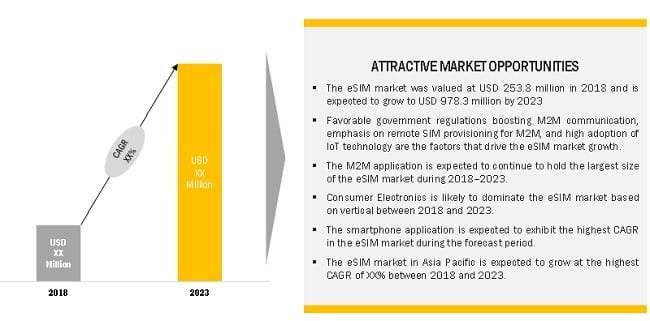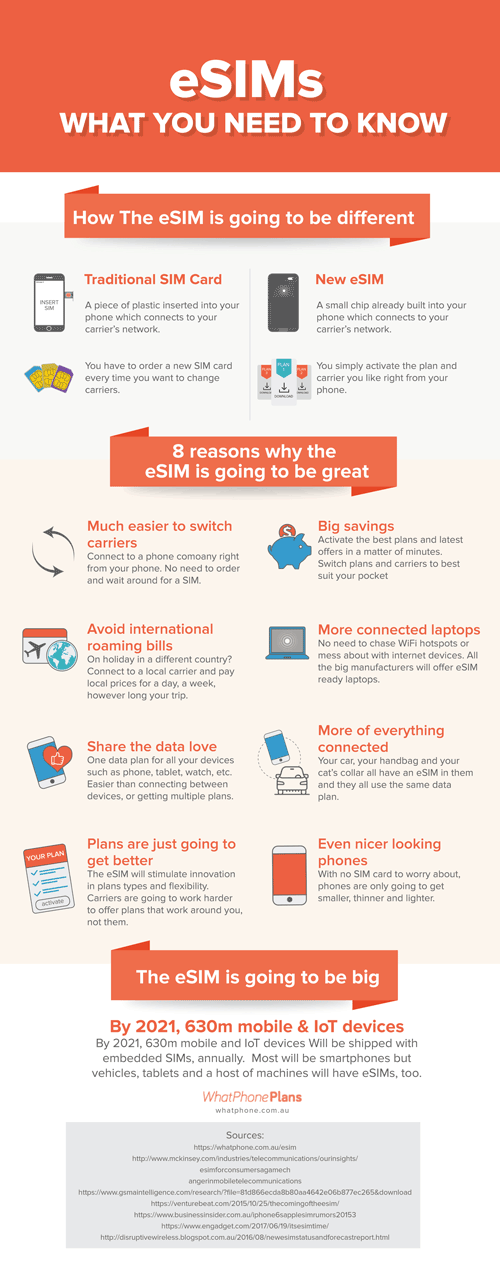The eSIM market
Analysts forecast the eSIM market will hit US$978.3 by 2023 – a 31 percent increase from US$253.3 in 2018. Asia Pacific is expected to have the greatest regional growth, and Australia is a major driver in that market.
Global eSIM market growth drivers. src
There are reasons for this trending growth, both in the consumer and business/manufacturing market. For consumers, the eSIM’s selling point is its convenience, while businesses and manufacturers see the technology as a way to connect all devices and machines to mobile networks without the aid of a secondary device like WiFi modems.
To fully grasp the eSIM’s benefits to all sectors, you have to understand how it works. The image below explains everything you need to know about the eSIM:
How eSIM technology works.
The eSIM is essentially a SIM card that’s built into the device so an actual, physical SIM card isn’t needed. The embedded SIM (eSIM) has all the capabilities of a physical SIM card and more. It can connect to mobile networks, and it allows users to digitally switch to any network that supports eSIMs, without needing a SIM card from the network in question.
- For the consumer, this is a boon. Imagine seeing a great mobile plan offer – one that’s so much better than your current telco’s offer that you immediately want to switch plans and take advantage. With an eSIM-capable smartphone, tablet, laptop, etc., you can switch right on the spot without having to visit a store or wait for a SIM card to be delivered, right from your device, if the network supports eSIMs.
- For telcos, this can mean a more speedy way to deliver network services to customers. It also means a lot of cost savings from not having to deliver physical SIM cards over the post. A lot of telco shops are open today simply to provide customers with SIM cards – they won’t be needed anymore, giving telcos another way to save money.
- Manufacturers can also use eSIMs to give their devices and machinery mobile network connectivity. This becomes more important to the growing IoT market (a major driver of eSIM market growth) where wireless network connectivity without secondary modems is a necessity – think smart home devices, driverless cars, farm machinery, robotics, and beyond.
Are eSIMs available in Australia?
eSIM technology has been in Australia since 2017. It started out with smaller devices like wearables, but is now available in larger devices like smartphones, tablets, and laptops.
Here’s a look at some popular eSIM devices in Australia:
- Apple Watch, 2017 and newer.
- Apple iPhones, 2018 and newer.
- Microsofts’s Surface Pro 4G LTE and the HP Sceptre.
- Google’s Pixel 2 and Pixel 2 XL.
What network support eSIM?
So far, only Mobile Network Operators (MNOs – the major networks) support eSIM in Australia. Telstra, Optus, and Vodafone all offer eSIM plans to some extent.
No Mobile Virtual Network Operators (MVNOS – the smaller networks) support eSIM in Australia right now, because MNOs haven’t given them access. This is currently affecting the competition in the market, leaving the major telcos to pretty much control how eSIM services are dispensed.
But although the ACCC doesn’t plan to step in yet, they’ve made it known that they are concerned about the lack of MVNO access to eSIM service, and MNOs are now working towards providing that access.
How to activate eSIM
Activating eSIM depends on the device and the telco in question. But the concept is generally the same – you activate your plan on the device itself either through the Settings menu or by scanning a QR code with your device’s camera. In some cases, you might have to give your telco a call.
Here’s a quick guide, although the setup varies based on the device.
- iPhone users go to Settings > tap Mobile > tap Add Mobile Plan > Scan QR code and follow prompts.
- Android users go to Settings > tap Network & Internet > add Mobile Network > Scan QR code and follow prompts.
Summing up
The eSIM market continues to grow, both globally and here in Australia. For consumers, the convenience the eSIM brings is the selling point. Telcos could also benefit from cost savings where physical SIM cards aren’t needed anymore. Manufacturers benefit from the eSIM giving mobile connectivity to devices and machinery without the need for secondary modems – a boon to the IoT industry.
As the eSIM continues to gain popularity, Australian telcos continue to increase support. While only MNOs currently provide eSIM support in the country, MVNOs shouldn’t be far off as the ACCC watches their access (or current non-access) to the market. When that happens, expect a much larger eSIM presence in Australia, which can only be good news for everyone.

